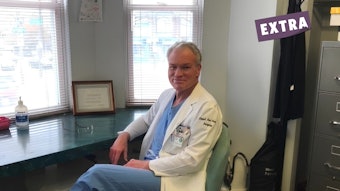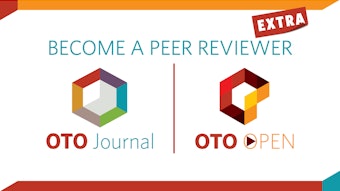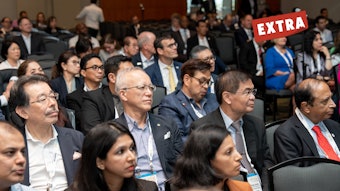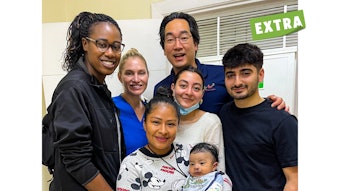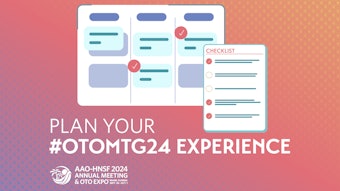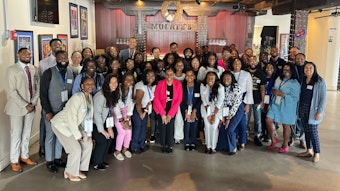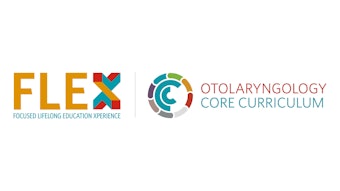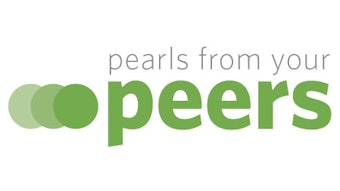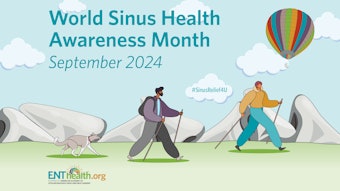Why Peer Review: An Interview with Associate Editor Sarah N. Bowe, MD, EdM
“Protecting the quality of research is paramount, as it can both directly and indirectly influence patient care through guidelines [that are built upon the existing literature].”

Sarah N. Bowe, MD, EdM, a pediatric otolaryngologist with the U.S. Air Force and Director of Pediatric Otolaryngology with the Defense Health Agency in San Antonio, Texas, has served as Associate Editor of Pediatric Otolaryngology for the AAO-HNSF's flagship journal, Otolaryngology Head and Neck Surgery and its sister journal, OTO Open, since 2019. Dr. Bowe caught up with the Bulletin to discuss her journey to peer reviewing, her guiding principles as an Associate Editor, the importance of protecting research quality for patient care, and her advice for peers interested in becoming reviewers.
Share a little about yourself, your career, and your journey to working with the OTO journals as an Associate Editor.
When I arrived at Brooke Army Medical Center in 2013, Mark E. Boston, MD, was one of the pediatric otolaryngologists and an Associate Editor for Otolaryngology-Head and Neck Surgery (OTO-HNS). While sitting in the clinic one day, he asked if I was interested in reviewing for the “white journal.” As a new attending, I jumped at the chance to be involved in the peer review process. Erik K. Weitzel, MD, was sitting nearby and offered his advice. “If you want to be an Associate Editor someday, never say ‘no’ to a review.” So, I was provided with both opportunity and expectations early in my career.
Of course, when I said yes, I had never done a peer review before. So, I went to the literature and found an outstanding resource, “How to Review Journal Manuscripts,” by Richard Rosenfeld, MD, MPH, former Editor in Chief of OTO-HNS.1 I made myself a template with the pertinent information that should be relayed to the Editor in Chief and authors and started reviewing. I had always intended to apply for a pediatric fellowship and to stay in academic medicine, so I expressed my interest in reviewing pediatrics papers. And, when I was asked to review an article, I never said ‘no.’ In addition, I submitted all my reviews on time. Owing to my thoroughness and consistency in submitting reviews, I was invited to sit on the Editorial Boards for OTO-HNS and OTO Open.
From 2016 to 2018, I was able to complete a pediatric otolaryngology fellowship at Massachusetts Eye & Ear Infirmary. During that time, I continued to review articles and support the journals. Shortly after returning to Brooke Army Medical Center as a pediatric otolaryngologist, John H. Krouse, MD, PhD, MBA, then Editor in Chief, offered me a position as an Associate Editor for Pediatrics.
Why did you choose to become involved with the journals and participate in peer review as part of volunteering your time to the specialty and patient care?
There are a few reasons that stand out. First, as a newer faculty member, I was looking for opportunities to get engaged with the American Academy of Otolaryngology-Head and Neck Surgery (AAO-HNS). As OTO-HNS and OTO Open are the official peer-reviewed publications of the AAO-HNSF, it seemed like a great way to volunteer with a relatively minimal and flexible time commitment. (Of course, this would have been true if I had said ‘no’ on occasion.) Second, I thought it would be a great way to see what other otolaryngologists were studying, including a sneak peek into topics that might not be quite ready for press. I quickly learned of a third reason, which is that it made me a far better researcher and writer. As I reviewed each paper, there was much that I had not known about various research methodologies and statistical approaches. This forced me to learn more to adequately critique each paper and offer constructive criticism to assist the authors with bringing their work to publication. This knowledge has continued to help immensely as I design studies and author publications.
What are your guiding principles for peer review or acting as an Associate Editor?
When it comes to guiding principles, I think that the following stand the test of time and position. The first consideration when reviewing a manuscript or deciding whether to send it out for review is whether it aligns with the journal’s mission, which is “to publish contemporary, ethical, clinically relevant information in otolaryngology-head and neck surgery … that can be used by otolaryngologists, clinicians, scientists, and specialists to improve patient care and public health.” If the article content does not align with the journal’s mission and will not be relevant to the readership, then it is not worth the time for it to undergo further review.
The second principle is also embedded in the mission statement and refers to ethical principles. Manuscripts should contain original content that has not been published previously. Any real or potential conflicts of interest related to the content must be explored and declared. Additionally, if applicable, approval should be obtained by an institutional review board. If a submission aligns with the mission and passes the ethical thresholds, then the remaining components of the review process, which includes an evaluation of the methodologic quality and generalizability, can proceed.
For you, what is the value of protecting the quality of research published in the OTO journals to patient care and the specialty?
The journals are the official peer-reviewed publications of the AAO-HNSF and thus provide a forward-facing representation of the society. The mission of OTO-HNS and OTO Open states that the ultimate goal is to “improve patient care and public health.” One great example of how the journals achieve this is by publishing clinical practice guidelines (CPGs). These guidelines include recommendations on many of the most common conditions treated by otolaryngologists and the broader medical community. The guidelines are informed by a systematic review of evidence, which is built upon the available literature. Thus, the CPGs illustrate the need for quality of research for every manuscript, as our higher levels of evidence rely upon the accuracy of each underlying article. Protecting the quality of research is paramount, as it can both directly and indirectly influence patient care through guidelines.
What encouragement would you give to your peers to consider becoming a reviewer?
As noted previously, there are many reasons to consider becoming a peer reviewer. Of course, one of the greatest barriers when you consider participating in the peer review process is time. The time needed to do a review will depend on the type of article, its complexity, your familiarity with the topic, and your level of experience doing peer reviews. Most people spend between one and three hours per review.
When starting out, I strongly recommend reading Dr. Rosenfeld’s article1 mentioned above. He and Dr. Krouse also presented an instruction course that provides an overview of the article, “How to Review Journal Manuscripts,” at the 2015 AAO-HNSF Annual Meeting & OTO EXPO. You can watch this course as a free recording. I have continued to use and share both of these resources in all of my editorial roles.
If you have an interest in reviewing, don’t hesitate to reach out to the Editorial Office at otomanager@entnet.org. It is possible to start reviewing with very little knowledge or experience, which I did! So, we would love to have you join the reviewer pool.
Previous Articles in this Series
Why Peer Review: An Interview with Associate Editor Lee M. Akst, MDWhy Peer Review: An Interview with Associate Editor Chau T. Nguyen, MD
Reference
- Rosenfeld, R.M. (2010), How to review journal manuscripts. Otolaryngology–Head and Neck Surgery, 142: 472-486. https://doi.org/10.1016/j.otohns.2010.02.010
The views expressed herein are those of the author(s) and do not necessarily reflect the official policy or position of the Defense Health Agency, the Brooke Army Medical Center, the Department of Defense, nor any agencies under the U.S. Government.
